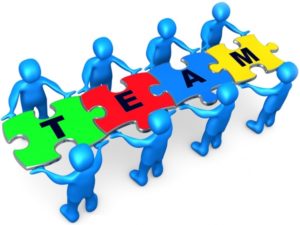
Developing Leadership
How great would it be if your employees said things like:
“I’m excited about my work.”
“This is a place where I can achieve my goals.”
“I feel safe. It’s okay to make a mistake, and I will learn from it.”
“I have some great ideas on how to improve things. I can’t wait to share them with my manager.”
With proper team development, you can develop leadership and hear comments like this from your staff. The secret to great leadership is not in hiring great employees. Instead develop your people. Even the best employees need your help realizing their potential. Your business needs a work environment where people can evolve with you as they help your business grow. But if your managers are overwhelmed and your employees aren’t communicating, “people development” can seem like an impossible task. By implementing routine meetings – with the intention of developing employees – you can achieve amazing results. These meetings, called Employee Development Meetings (EDM), will help you to create a workplace where people motivate themselves to do better, feel valued for the work that they do, and are constantly looking for ways to move beyond their limitations.
The Employee Development Meeting
The Employee Development Meeting is a regularly-scheduled meeting between an employee and their direct supervisor that is:
- A forum for discussion, problem-solving, conflict resolution, and planning that leaves your employees feeling important. They want to be listened to and empowered to take action.
- A time to discuss current work in order to: make agreements for work to be accomplished, prioritize and discuss any exceptions, exchange pertinent information, clarify procedures and results, and conduct other follow-ups related to current work.
- A coaching session that helps people stay on track and focus on their goals (both personal and professional) so their experience in your business becomes more positive and meaningful.
Managers are likely the busiest people within an organization. When you take into account their performance objectives, meetings, project work, and employee management responsibilities, it’s no wonder they are the ones rushing around the office. In typical 10-50 person companies, the CEO and the staff employees are actually able to focus on one or two top priorities, but the managers are constantly balancing their responsibilities to both the CEO and the employees who report to them. They still have to get their own work done on top of their daily balancing act.
Using the Employee Development Meeting (EDM) allows managers to keep in touch with their employees and stay on top of their accountabilities. While you might be thinking that the last thing you need is to add another meeting to your schedule, the EDM system is designed to condense many smaller meetings into one highly focused session, reducing the need for random drop-ins, frequent email exchanges, and other interruptions that distract your managers.
Setting the Stage for Successful Employee Retention
If the EDM system makes sense for your organization, set up a meeting with all your managers to go over the EDM rules and have them do the same with their reporting employees. Managers should set up EDMs for at least three months. Once these meetings are on the schedule, look for opportunities to eliminate other non-essential meetings—after all, this is also about saving time and increasing efficiency.
The Manager’s Role:
- Be consistent: Set the frequency, regular time, and basic agenda for EDMs and stick to it. Promptly reschedule any missed meeting.
- Be present: Conduct EDMs in a quiet place free of interruptions and distractions to allow a real dialogue to occur.
- Be committed: Inquire, listen, and secure commitments. Find out what is going on with the employee (good and bad), address key work related issues, announce new projects and tasks, answer or clarify any questions and set clear expectations regarding responsibilities.
The Employee’s Role:
- Provide updates, not excuses: Be prepared to report on project status and inform managers in advance when projects are not going to be delivered on time.
- Ask questions and for help when needed: EDMs are open, two-way exchanges where both parties share responsibility in bringing up topics, communicating their needs, and discussing issues.
- Show your commitment: Employees are assigned projects and must make commitments to deliver. Additionally, they must commit to improving their skills and performance when problems arise.
The Result
The EDM is a straightforward communication opportunity that is consistent, focused, and highly accountable. When both parties are on the same page with projects, responsibilities, work-related and interpersonal issues, there won’t be a need for extra emails and meetings that rarely resolve issues. By creating a safe place for development, employees and managers will be able to communicate with each other on a deeper level about their work, performance, and goals.
Whatever result you’re pursuing, the Employee Development Meeting moves you and your employees one step closer to the satisfying, motivating work environment that most people dream of, but few ever experience.
Prepare for positive results when you start hearing your team members say:
“I love my job!”
“I can achieve my goals here.”
“It’s ok to make mistakes, they are learning tools.”
“My manager loves to hear my ideas for improvements.”
Start the chain of developmental meetings and see the progress and improvements it creates in your organization. Then recognize and encourage these improvements and harness the power of recognition.
